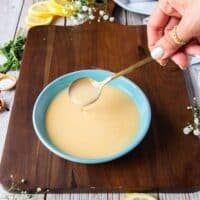
Citrus Beurre Blanc
Ingredients
- 1/4 cup White wine
- 2 Tablespoons shallots minced
- 2 Tablespoons citrus juice lemon only or lemon, orange and grapefruit
- 1 Tablespoon citrus zest lemon or a combo of orange and lemon
- 1 1/2 Tablespoons Cream
- 1/4 teaspoon each salt and pepper or to taste
- 6 Tablespoons Butter unsalted, cold, cut into 1 cm cubes
- 1-2 Tablespoons fresh herbs optional such as oregano , minced
Instructions
-
In a 3 quart sauce pan over medium heat, add the white wine, shallots, citrus juices and zests.
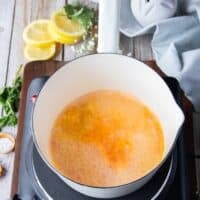
-
Let the mixture simmer until it has reduced over low heat for 8 minutes.
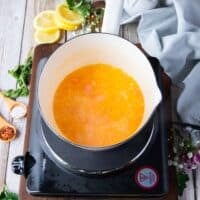
-
Then add in the cream and season the sauce.
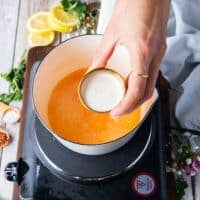
-
Turn off the heat and add in the butter, one cube at a time while whisking until it has dissolved.
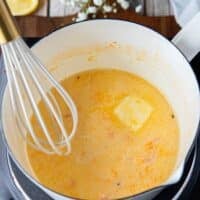
-
When the butter is completely whisked in and blended into the sauce, the sauce is ready.
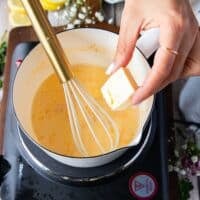
-
Strain the sauce to remove the tiny bits of shallots and zests for a silky smooth luscious feel.
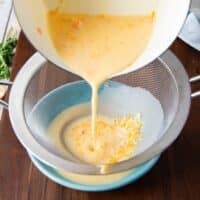
-
After staining the sauce, it is completely ready to use. You can optionally add in some fresh herbs for bright taste and colour or use it as is.
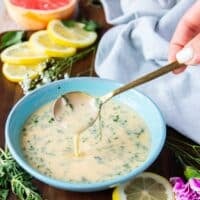
Recipe Video
Recipe Notes
Tips for Beurre Blanc Sauce
- Use cold butter, ALWAYS. This prevents the sauce from separating.
- Don’t overheat beurre blanc sauce, ever. Keep the pan warm but not hot. Likewise, the high heat will separate the sauce.
- Don't speed up the reduction step, allow the liquids to soak up the shallot flavor well.
- Add butter gradually. You need to be whisking one butter cube at a time to ensures a stable emulsion.
- Strain the sauce for a velvety smooth finish.
- You can add the herbs initially with the shallots if you want a completely chunk free sauce.
- Serve right away as beurre blanc doesn’t reheat well.
- Make SURE TO READ below how to fix a broken beurre blanc, and common mistakes.
Variations
Try lime juice and zest for a zestier sauce. While some make this sauce with red wine, it definitely won't be white sauce. It will rather be a more complex flavored sauce.
Can I make beurre blanc ahead of time?
Not really because it doesn't reheat so well. If you want to make it ahead of time, keep it warm over super low heat or in an insulated container for up to 30 minutes.
What proteins go best with citrus beurre blanc?
Seafood is the best! Scallops, halibut, Black cod, salmon, and shrimp. Our favorite is Chilean Sea Bass Recipe with citrus beurre blanc! It’s also excellent with chicken or Potatoes, or any roasted vegetables.
What’s the difference between beurre blanc and hollandaise?
Both are French butter sauces, but hollandaise uses egg yolks as the emulsifier, while beurre blanc relies only on butter.
Can I use cream to stabilize the sauce?
Yes TOTALLY yes! By adding just a tablespoon of heavy cream before whisking in the butter, this helps stabilize the mixture for a fool proof sauce.
Can I make it dairy-free?
Simply substitute high-quality vegan butter, but you may need more butter. The texture may be slightly looser than traditional beurre blanc.
What’s the difference between orange and lemon beurre blanc?
Orange beurre blanc is slightly sweeter and less acidic, making it a great choice for delicate white fish or roasted chicken. Lemon beurre blanc is sharper, brighter, and more refreshing perfect for other seafoods. Today we combined both so it's super versatile to use.
Can You Make a Lemon Butter Sauce Without Wine?
While wine is traditional, you can substitute white wine vinegar. You can even use chicken stock with citrus juice for a non alcoholic version. The acidity is key however to balance the richness of the butter.
What are other French sauces for fish?
Aside from citrus beurre blanc, try our Black Cod Recipe for another creamy sauce.
Is beurre blanc hard to make at home?
Not at all! Once you follow the tips above like using cold butter and whisking slowly. If you're in doubt, add a splash of cream at the end to stabilize the sauce.
Can I add Parmesan to citrus beurre blanc?
While not traditional, a touch of Parmesan can deepen the flavor and give the sauce a subtle nuttiness. It works especially well non seafood dishes in general.
What are the common beurre blanc mistakes?
The most common mistakes include overheating the sauce (which causes it to separate. Other mistakes include adding the butter too quickly, or using butter that’s too warm. Also, not reducing the wine and vinegar mixture enough before whisking in the butter, this will create a thin, watery sauce instead of the luscious, velvety texture beurre blanc is known for.
What should beurre blanc taste like?
Beurre blanc should taste buttery, smooth, and rich, with just enough acidity to cut through the fat. The shallots and wine give it a subtle depth, while the herbs and citrus version adds brightness and a refreshing edge. A well-made beurre blanc shouldn’t taste overly sour or heavy.
What is the cheat for beurre blanc?
A common cheat is to add a splash of heavy cream to the reduction before whisking in the butter. The cream helps stabilize the emulsion, making it more forgiving for beginners. While this isn’t strictly traditional, it gives you a silky sauce that’s less likely to separate.
Another cheat you can opt for is blending the sauce with an immersion blender for extra stability.
How do you fix a broken beurre blanc?
If your beurre blanc starts to break, take it off the heat right away. Whisk in a teaspoon of cold water or a cube of cold butter to bring it back together. If it fully splits, you can make a fresh reduction and gradually whisk the broken sauce into it. This way you're basically re emulsifying it from scratch.
What to Serve with Citrus Beurre Blanc
Chilean Sea Bass Recipe
Black Cod Recipe
Air Fryer Salmon Bites
Grilled Lobster Tail
Crawfish Tail
Crab Legs
Grilled Halibut
Perch
Green Mussels